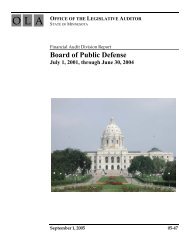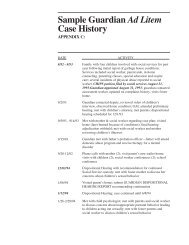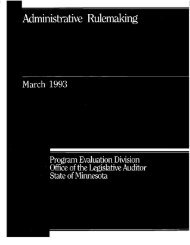Occupational Regulation - Office of the Legislative Auditor
Occupational Regulation - Office of the Legislative Auditor
Occupational Regulation - Office of the Legislative Auditor
Create successful ePaper yourself
Turn your PDF publications into a flip-book with our unique Google optimized e-Paper software.
90 OCCUPATIONAL REGULATION<br />
board performance could be better monitored through increased oversight. With<br />
increased oversight, whe<strong>the</strong>r through sunset reviews, improved biennial reporting,<br />
or by some o<strong>the</strong>r means, <strong>the</strong> Legislature and <strong>the</strong> public could have more<br />
confidence that regulatory boards are truly working in <strong>the</strong> public’s interest.<br />
REGISTERED DENTAL ASSISTANTS<br />
Legislation in<br />
1998 sought<br />
licensure for<br />
registered<br />
dental<br />
assistants.<br />
Registered dental assistants have been regulated by <strong>the</strong> Board <strong>of</strong> Dentistry since<br />
1977. In 1994 <strong>the</strong>y were registered in 4 states and regulated in 11 states. 3<br />
(Unregulated dental assistants are employed in Minnesota but do not perform any<br />
intra-oral functions.) In 1998, S.F. 3408 was introduced. The proposed<br />
legislation sought licensure for registered dental assistants. The bill did not<br />
change <strong>the</strong> activities defining <strong>the</strong> scope <strong>of</strong> practice for dental assistants, and it<br />
would have given registered dental assistants <strong>the</strong> same level <strong>of</strong> credentialing as<br />
dental hygienists. The Minnesota Dental Assistants Association (MDAA), which<br />
represents about 20 to 30 percent <strong>of</strong> Minnesota dental assistants, supported <strong>the</strong><br />
bill. The board did not oppose S.F. 3408 because registered dental assistants are<br />
required to meet education, exam, and continuing education requirements as do<br />
dental hygienists. The bill was introduced late and received no hearings.<br />
The case study <strong>of</strong> dental assistants provides an example <strong>of</strong> an attempt to change<br />
<strong>the</strong> inconsistent use <strong>of</strong> <strong>the</strong> words certify, register, and license in Minnesota. Since<br />
registered dental assistants have a defined scope <strong>of</strong> practice, education, exam, and<br />
continuing education requirements, it is logical that <strong>the</strong>y be licensed. The fact that<br />
<strong>the</strong>y are currently referred to as registered dental assistants, yet <strong>the</strong>y have title<br />
protection and practice protection illustrates <strong>the</strong> need for a review and<br />
standardization <strong>of</strong> terminology as we recommend in Chapter 3.<br />
LEAD WORKERS<br />
In 1998,<br />
legislation was<br />
enacted<br />
bringing<br />
Minnesota law<br />
into line<br />
with EPA<br />
requirements<br />
for licensing<br />
lead workers.<br />
Lead workers were regulated in Minnesota in 1993 by <strong>the</strong> Department <strong>of</strong> Health’s<br />
Division <strong>of</strong> Environmental Health. Only workers doing intentional lead removal<br />
are required to be licensed. If an individual or contractor removes lead incidental<br />
to a remodeling project, no license is required. Fur<strong>the</strong>rmore, <strong>the</strong>se rules only<br />
apply to work done on buildings that have <strong>the</strong> potential to be homes or places<br />
frequented by children.<br />
The impetus for regulating this occupational group was <strong>the</strong> 1992 Federal Housing<br />
Act, which mandated regulation <strong>of</strong> lead removal, and <strong>the</strong> 1996 Environmental<br />
Protection Agency (EPA) requirements that followed. In 1998 H.F. 2334 and S.F.<br />
2108 were introduced to bring Minnesota statutes in line with <strong>the</strong> EPA standards<br />
relating to lead removal. Recognizing <strong>the</strong> need to update Minnesota’s standards,<br />
and desiring to avoid <strong>the</strong> alternative <strong>of</strong> direct regulation by <strong>the</strong> EPA, <strong>the</strong> bills were<br />
backed by <strong>the</strong> Minnesota Department <strong>of</strong> Health. There were no groups opposed<br />
to <strong>the</strong> changes and <strong>the</strong> bills were passed with minimal discussion.<br />
3 Ibid.








